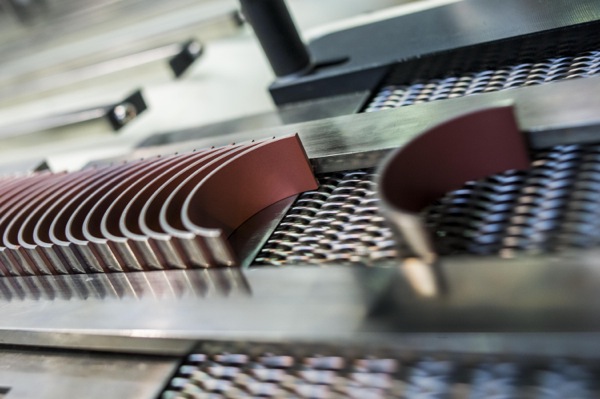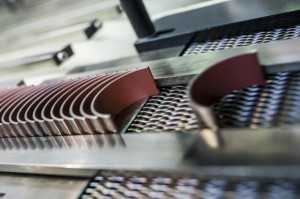 In the never ending quest for better performance, durability and reliability, various types of surface coatings and treatments have evolved as solutions for problems that have vexed engine builders for years. Coatings that were once considered exotic race-only solutions are now being used on a wide variety of stock and performance applications.
In the never ending quest for better performance, durability and reliability, various types of surface coatings and treatments have evolved as solutions for problems that have vexed engine builders for years. Coatings that were once considered exotic race-only solutions are now being used on a wide variety of stock and performance applications.
If you’re not familiar with coating technology and the benefits coatings can provide, keep reading because it’s time you get up to speed on what’s available and what coatings can do.
First of all, there are different types of coatings for different purposes:
Anti-Scuff & Anti-Friction Coatings
These can be used on engine bearings, piston skirts and valvetrain components to reduce friction and provide lubrication in the absence of normal lubrication. Most of these are some type of dry film lubricant that contain molybdenum disulfide, graphite, tungsten disulfide and/or PTFE (Teflon) in a thermosetting polymer binder (water or solvent based). Many of these coatings also have oil retention properties that attract and hold oil to maintain lubrication on critical surfaces on bearings and piston skirts.
Hard Surface Coatings
These include hard anodizing aluminum pistons, nitriding crankshaft journals, and applying thin film coatings such as titanium nitride, chromium nitride or Diamond-Like Carbon (DLC) on valves, lifters, wrist pins and other parts.
Thermal Barrier Coatings
These include various types of metallic and ceramic coatings that insulate parts and reflect heat. Thermal barrier coatings are typically used on the tops of pistons and inside combustion chambers to improve thermal efficiency and power, and to help pistons and other parts run cooler.
When used on exhaust manifolds and headers, thermal barrier coatings retain more heat in the exhaust which increases exhaust velocity and improves scavenging. It also reduces the amount of heat that is radiated into the engine compartment. Thermal barrier coatings can also be used on the undersides of intake manifolds, carburetor throttle bodies and in the intake manifold and cylinder head ports to help keep the air/fuel mixture cooler (which means more horsepower and less risk of detonation and preignition).
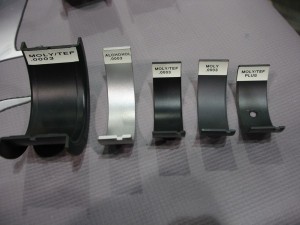
Thermal Dispersants
These are coatings that improve the rate at which heat radiates away from a surface. Thermal dispersants are one of the most underutilized coatings but can be effectively used to help the engine, oil and coolant run cooler. Thermal dispersant coatings can be applied to oil pans to help radiate heat away from the oil, to carburetor fuel bowls and the upper side of intake manifolds to help cool the incoming air and fuel, to radiators, oil coolers and turbocharger intercoolers to improve thermal efficiency (as much as 20 percent or more in many cases!), and to help cool such parts as alternators, transmission housings, differentials or even electric motors.
Oil Shedding Coatings
These prevent oil from sticking to surfaces so it will return to the oil pan more quickly. These types of coatings cause oil to bead up and roll off rather than wick and stick to the surface. Applications include coating crankshaft counterweights and connecting rods to reduce crankcase windage and drag, and coating the insides of valve covers, valley covers and oil pans to improve oil return to the oil pan.
Before we move on to more specifics, it’s important to understand that different applications require different types of coatings.
There is no single magic coating that does it all. The coatings required inside a Top Fuel drag motor are going to be different from those for a Saturday night dirt track racer or a street performance motor.
The real experts on this topic are the people who apply the coatings and the manufacturers who develop and supply the coating raw materials. They have the experience and know-how to guide you in the selection of which types of coatings will accomplish what you are trying to achieve. Let them tell you which coating will work best for a particular application rather than trying to tell them what type of coating you want applied to a part.
Quality control of the coating materials that are used and how they are applied is also essential to assure good surface adhesion, the proper surface finish and dimensional control. Some coatings are so thin that they have little or no effect on assembly tolerances. But in some cases, the thickness of a coating can be increased to compensate for wear or to address other issues such as piston slap or excessive piston-to-bore clearances.
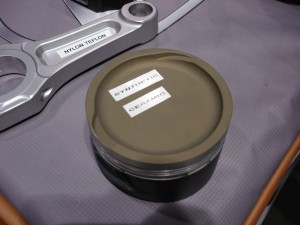
Bearing Coatings
Bearing coatings first appeared back in the 1970s as a means of helping crankshaft rod and main bearings survive grueling racing conditions. If an engine loses oil pressure for any reason during a race, it’s usually the end of the race for that engine. Rod and main bearings won’t survive very long at high RPM without a protective oil film between the bearings and crank. If the oil film is lost, the bearing will scuff or seize resulting in a spun bearing, a damaged crank journal and/or possibly a broken connecting rod.
Bearing coatings provide a layer of dry film lubrication that takes over when there is little or no oil film in the bearing. That includes dry starts as well as loss of oil pressure while the engine is running. The sacrificial coating provides temporary lubrication that often prevents expensive damage to the crank journals — at least for awhile.
Many bearing coatings also attract and hold oil on the bearing surface. This allows some lubrication to continue even if oil pressure is lost momentarily during hard acceleration, hard cornering or because of high speed cavitation in the oil pump. Many oil pumps cavitate above 5500 RPM causing oil pressure to fluctuate or even drop. Using coated bearings reduces the risk of bearing damage or failure if an engine has a history of oil pressure problems.
Most bearing coatings are relatively thin, only about .0001 to .0003 inches thick so they should not affect normal bearing clearances. Coatings can also be burnished down to near zero thickness and still provide a layer of protection.
One of the latest applications of bearing coatings is to protect the crankshaft bearings in new cars that utilize fuel saving Stop/Start technology. Many hybrids as well as a growing number of non-hybrids shut the engine off at a stop light or when a vehicle stops moving for more than a few seconds to save fuel. The problem is as soon as the engine shuts off, oil pressure drops to zero and oil starts to drain out of the bearings.
Today’s ultra-thin 0W-20, 0W-40 and even 5W-20 oils are great for reducing friction but not so great at maintaining the oil film in the bearings when oil flow to the bearings stops. Consequently, there’s a significant potential for increased bearings wear in these Stop/Start engine applications depending on how frequently the engine is shut off and restarted. It’s not quite as bad as cold starting an engine that sat overnight for several hours, but it’s not the same as continuous driving with a steady supply of oil either.
Another application for coated bearings is for engines that may experience high cornering forces and oil starvation issues with their stock oil systems. General Motors is using specially coated rod and main bearings in their Corvette LS7 engines. The bearing manufacturer says its proprietary polymer coating reduces bearing wear up to 500 percent and fatigue by 20 percent over standard overlays. The bearings also have partial oil grooves to reduce oil pump losses by 30 percent.
Research is also being done by several bearing manufacturers to develop next generation bearings that will use some type of coating in place of traditional babbit in a trimetal bearing. These new “leadless” trimetal bearings may be used in engines with Stop/Start technology or as a substitute for traditional trimetal or bimetal bearings.
Using coated rod and main bearings is certainly not a necessity for many racers, but it does provide an extra layer of protection in applications that can be hard on bearings.
One supplier told us that some of their drag racing customers are running the same coated bearings for up to three years (over 850 runs!) without any problems. When the engines are torn down for inspection, the surface of the bearings show almost no wear — although the bearings have lost some crush due to the pounding they’ve taken over time. Even so, the addition of a coating to a high quality base bearing allows these racers to save a considerable amount of money over several racing seasons because they don’t have to replace bearings as often.
Top Fuel drag racing is one of the most demanding applications as engine bearings are concerned. Hammering the bearings with up to 12,000 PSI or more for a four second run down the quarter mile usually means the bearings have to be replaced after every race. But according to one coating supplier, its special coating for Top Fuel bearings allows the same set of bearings to last up to four or more runs.
Coating Pistons
Many piston suppliers offer pistons with anti-scuff skirt coatings either as a standard product feature or an extra-cost option. The coatings may be applied by a silk screen printing process or sprayed on. Some coatings are designed to be more of a break-in coating while others are designed to last the life of the piston. Break-in coatings typically scrub off as the piston and rings seat in while long-life anti-friction/anti-scuff coatings protect the piston against dry starts, loss of lubrication on the cylinder walls and overheating.
Most anti-friction/anti-scuff skirt coatings are relatively thin (.0005 to .001 inches) so there is no need to compensate for piston-to-bore clearances when the pistons are installed. Normal clearances can be used as if the coating wasn’t there.
The thickness of the skirt coating may be increased in some applications to compensate for piston or bore wear, to reduce piston slap or piston vibrations. On diesel applications, some engine builders have found that using a heavier anti-friction skirt coating reduces cavitation wear in wet cylinder liners. Apparently the skirt coating acts like a vibration damper to cushion the piston as it moves up and down in the cylinder.
Anti-friction/anti-scuff skirt coatings can also be combined with other piston surface treatments such as hard anodizing. Anodizing forms a hard, corrosion resistant layer on the surface of aluminum. There are various types of anodizing treatments, and some that form the hardest surface layer can also leave the surface slightly rougher. This improves the durability and wear resistance of the piston and rings, but may increase bore wear due to the abrasive nature of the anodizing.
Some anodizing treatments are somewhat kinder in that they can impregnate molybdenum disulfide or other compounds into the surface to make it both hard and self-lubricating.
For drag racing, hard anodizing pistons may not make much difference in terms of bore wear. But for a street engine or endurance racing such as NASCAR or road racing, a hard anodized skirt coating may increase cylinder wear. To reduce bore wear, the piston skirt can be coated with a dry film moly-based lubricant. The cylinder bores may also be coated with a wear-resistant surface treatment such as Nikasil (a hard electrodeposited coating of nickel and silicon carbide). Nikasil coated cylinders are quite popular in many forms of racing, from motorcycles and marine to off-road and circle track.
For engines that have aluminum cylinder bores and aluminum pistons, a thin coating of iron can be applied to the pistons to create a barrier between the similar metals. Without some type of coating, uncoated aluminum pistons won’t survive in an aluminum bore. Iron particles may also be used in some skirt coatings for pistons that are used in cast iron blocks or aluminum blocks with iron sleeves.
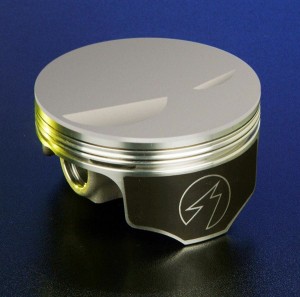
lubricity, heat control and performance.
Photo Courtesy of Speed-Pro.
Thin Film Coatings
Thin, hard coatings can also be applied to the wrist pin bores in pistons or to the wrist pins themselves if increased durability is needed. Thin film coatings include PVD (Physical Vapor Deposition) or DLC (Diamond-like carbon) coatings that create an extremely thin (microns thick) layer on the surface. The coating increases hardness and wear resistance while also reducing friction.
Thin film coatings, whether applied chemically, by a PVD process or plasma spray, are often used on valves and lifters.
Titanium nitride and Chromium nitride create a hard wear-resistance layer that helps valves and lifters hold up better in demanding applications. Diamond-like carbon is another coating material that is often used in high end racing for added wear-resistance and durability, but it’s more expensive than most other processes.
Heat Reflective Coatings
Thermal barrier top coatings for pistons can be used to improve durability and power. These may be spray and bake coatings, or applied by some type of high temperature plasma spray. Thermal barrier coatings reflect heat to keep more heat and pressure in the combustion chamber. Gains of 8 to 10 horsepower can often be seen on a dyno after pistons have been coated. The coating also reduces heat transfer into the piston, wrist pin and rings.
Most of the coating suppliers we interviewed recommend using a thermal barrier coating on pistons if the engine will use some type of power adder such as nitrous oxide, a turbocharger or supercharger. Thermal barrier coatings can also be applied to the combustion chambers in the cylinder heads, and valve faces to reflect heat. Aluminum heads pull a lot of heat out of the combustion chamber, so slowing down the rate of heat transfer means more usable energy remains in the cylinders. It also means less heat transfer to the coolant (cooler running engine) and less heat transfer to the intake manifold (cooler air/fuel charge).
Thermal barrier coatings on exhaust manifolds and headers increase exhaust velocity and scavenging efficiency while reducing engine compartment temperatures. The coatings also provide cosmetic protection that inhibits rust and corrosion. One coating supplier said adhesion is a challenge on exhaust components because of the constant expansion and contraction of the manifolds or tubing. This requires careful preparation of the exterior surface of the manifolds or pipes so the base coating will stick. Their particular coating is applied in multiple layers using slightly different materials in the upper layers so the coating will last.
Some bright ceramic metallic coatings for exhaust components are more for appearance and are less effective at reflecting heat. Sometimes the “ugliest” thermal barrier coatings actually provide the best heat retention and performance.
Valvetrain Coatings and Protection
Valve spring fatigue and failure is often the result of high temperatures and friction, especially with double or triple-coil valve springs. Coating the springs can reduce friction and help the springs run cooler and last longer. Thermal dispersant coatings are another option for valve springs to help them run cooler.
The tips of pushrods can dig into the rocker arms at maximum valve lift, so coating the tips with an anti-friction coating can reduce wear.
Lifters and cam lobes that are experiencing wear problems can often benefit from thin film PVD or DLC coatings. Micro-polishing camshaft and crankshafts can also reduce friction by providing a smoother surface finish.
If you are not taking advantage of all the benefits these various types of coatings offer, it’s time to investigate coatings further.
Talk to some coating applicators and manufacturers to find out more about their products and how they can help your engines last longer, run better and experience fewer problems.

